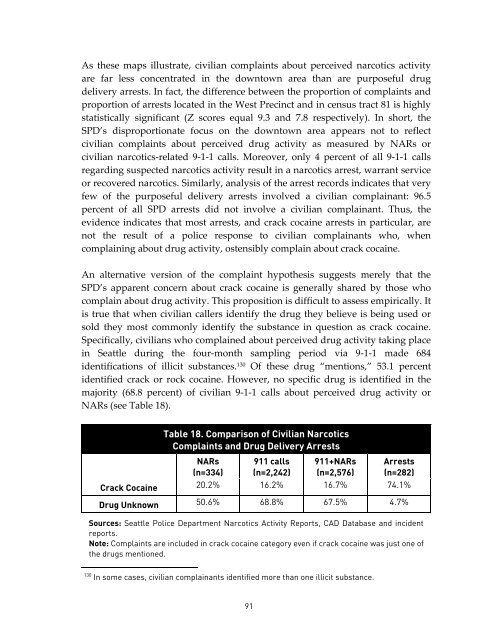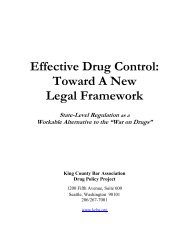RACE AND THE ENFORCEMENT OF DRUG DELIVERY LAWS IN ...
RACE AND THE ENFORCEMENT OF DRUG DELIVERY LAWS IN ...
RACE AND THE ENFORCEMENT OF DRUG DELIVERY LAWS IN ...
Create successful ePaper yourself
Turn your PDF publications into a flip-book with our unique Google optimized e-Paper software.
As these maps illustrate, civilian complaints about perceived narcotics activity<br />
are far less concentrated in the downtown area than are purposeful drug<br />
delivery arrests. In fact, the difference between the proportion of complaints and<br />
proportion of arrests located in the West Precinct and in census tract 81 is highly<br />
statistically significant (Z scores equal 9.3 and 7.8 respectively). In short, the<br />
SPD’s disproportionate focus on the downtown area appears not to reflect<br />
civilian complaints about perceived drug activity as measured by NARs or<br />
civilian narcotics-related 9-1-1 calls. Moreover, only 4 percent of all 9-1-1 calls<br />
regarding suspected narcotics activity result in a narcotics arrest, warrant service<br />
or recovered narcotics. Similarly, analysis of the arrest records indicates that very<br />
few of the purposeful delivery arrests involved a civilian complainant: 96.5<br />
percent of all SPD arrests did not involve a civilian complainant. Thus, the<br />
evidence indicates that most arrests, and crack cocaine arrests in particular, are<br />
not the result of a police response to civilian complainants who, when<br />
complaining about drug activity, ostensibly complain about crack cocaine.<br />
An alternative version of the complaint hypothesis suggests merely that the<br />
SPD’s apparent concern about crack cocaine is generally shared by those who<br />
complain about drug activity. This proposition is difficult to assess empirically. It<br />
is true that when civilian callers identify the drug they believe is being used or<br />
sold they most commonly identify the substance in question as crack cocaine.<br />
Specifically, civilians who complained about perceived drug activity taking place<br />
in Seattle during the four-month sampling period via 9-1-1 made 684<br />
identifications of illicit substances. 130 Of these drug “mentions,” 53.1 percent<br />
identified crack or rock cocaine. However, no specific drug is identified in the<br />
majority (68.8 percent) of civilian 9-1-1 calls about perceived drug activity or<br />
NARs (see Table 18).<br />
Table 18. Comparison of Civilian Narcotics<br />
Complaints and Drug Delivery Arrests<br />
NARs<br />
(n=334)<br />
911 calls<br />
(n=2,242)<br />
911+NARs<br />
(n=2,576)<br />
Arrests<br />
(n=282)<br />
Crack Cocaine 20.2% 16.2% 16.7% 74.1%<br />
Drug Unknown 50.6% 68.8% 67.5% 4.7%<br />
Sources: Seattle Police Department Narcotics Activity Reports, CAD Database and incident<br />
reports.<br />
Note: Complaints are included in crack cocaine category even if crack cocaine was just one of<br />
the drugs mentioned.<br />
130<br />
In some cases, civilian complainants identified more than one illicit substance.<br />
91

















